Learn about NFPA emergency standards and codes, OSHA guidelines, and why fire safety remains a priority during this pandemic
A radically different reality is unfolding across the world, and organizations and individuals are scrambling to put coronavirus plans in place to protect their homes, businesses, and people. Fire safety may not be the first thing on people’s minds amidst a global pandemic, but it remains critically important. And emergency plans are vital, which is why the National Fire Protection Association (NFPA) and the Occupational Safety and Health Administration (OSHA) publish guidelines for creating safety and continuity plans.
This blog details essential NFPA and OSHA advice for emergency preparedness, plus explains fire safety risks and why fire protection can’t be overlooked during this global emergency. Sections include:
- The need for coronavirus emergency operations plans
- Crafting coronavirus procedures: how NFPA can help
- NFPA tips for creating coronavirus emergency operations plans
- OSHA emergency-preparedness resources
- What are the fire safety risks during a pandemic?
- Evacuated buildings and fire protection ITM
- Coronavirus plans and addressing behaviors that increase fire risks
Quick Response Fire Supply (QRFS) remains fully operational and committed to helping your business maintain the highest levels of fire safety. Call us at +1 (888) 361-6662 or email support@qrfs.com if you have any questions or need fire protection equipment.
The need for coronavirus emergency operations plans
As the confirmed cases of COVID-19 increase rapidly, national, state, and local governments are taking drastic measures to enforce social distancing that slows the rate of infection. Unprecedented closures of the places people typically gather are mandated in many communities, from schools to businesses to beaches.
Telecommuting has reached record-breaking levels, bars and gyms are shut down, and many restaurants have closed or switched to take-out and delivery service only. San Francisco put its entire community on lockdown for three weeks.
Hopefully, such drastic measures will lessen the impact of the global pandemic, enabling life to return to normal soon. But for now, business owners must plan for the worst by putting coronavirus procedures in place that maximize safety and minimize the impact on operations.
For some, that means dusting off old pandemic plans implemented during the spread of the H1N1 influenza virus in 2009. For many, it means scrambling to establish new emergency preparedness guidelines. Remember, it is never too late to start emergency planning. And it is essential to carefully think through plans that keep people safe and support the long-term sustainability of a business.
In the rush to ensure business continuity, it can be all too easy to let fire safety lapse. Unfortunately, that can lead to catastrophic outcomes when first responders fall ill. At the same time, people engage in unsafe practices—like hoarding flammable supplies and propping open fire doors to avoid touching dirty handles.

Crafting coronavirus procedures: how NFPA can help
Even if the first positive test has yet to send shockwaves throughout your community, the effects are already here. It’s time to evaluate your readiness. As the coronavirus pandemic spreads, the National Fire Protection Association urges all organizations to put strategic plans in place that can be rolled out quickly as the threat continues to grow.
NFPA may not be the first place people turn to for resources in a medical emergency. But its role as an all-hazards knowledge leader has led to the creation of many tools that organizations can use to craft or update continuity plans. NFPA also offers detailed guidance for protecting those who may be exposed to infectious diseases, like first responders.
At a minimum, this is a must-look: the NFPA Emergency Preparedness Checklist is a relatively short, actionable list of items that help organizations review or develop coronavirus plans.
In addition, the following codes and standards can help address the coronavirus pandemic through measures related to prevention, mitigation, preparedness, response, and recovery. Free access is available at nfpa.org. Review the list and select what makes sense for your organization:
- NFPA 1600: Standard on Continuity, Emergency, and Crisis Management was recognized as the national preparedness standard by the 9/11 Commission, addressing a myriad of events, including pandemics. It offers vital information on conducting risk assessments, a business impact analysis, and capabilities and needs assessments, plus developing emergency and recovery plans. The U.S. Department of Homeland Security adopted NFPA 1600 as a voluntary consensus standard for emergency preparedness.
- NFPA 99: Health Care Facilities Code is an indispensable resource for decision-makers in the healthcare field. It offers essential safety information and requirements for emergency planning, isolation spaces, infection control, IT and data infrastructure, and more.
- NFPA 1581: Standard on Fire Department Infection Control Program provides the minimum requirements for infection control programs at fire departments. It aims to help identify and limit the potential of infectious exposures for first responders during the performance of their duties. It also addresses risks in responders’ work and living environments.
- NFPA 1999: Standard on Protective Clothing and Ensembles for Emergency Medical Operations provides requirements for clothing and specific respiratory devices used by first responders, as well as health care workers at facilities where treatment is rendered.
Once social distancing restrictions are lifted, NFPA also offers facility planning workshops to walk participants through the process of developing new emergency preparedness plans.
NFPA tips for creating coronavirus plans
The 2019 edition of NFPA 1600 offers detailed instructions for establishing effective emergency management and business continuity during any type of emergency, from natural disasters to pandemics to acts of terrorism.
It’s important to remember that planning should never happen in a vacuum: Establishing a planning team and inviting key stakeholders, vendors, and emergency partners to participate can be critical to success.
Here’s an overview of what NFPA suggests for putting a coronavirus plan in place:
Identify the event that requires emergency planning
From the 2019 edition of NFPA 1600
5.1.5 Crisis management planning shall address an event, or series of events, that severely impacts or has the potential to severely impact an entity’s operations, reputation, market share, ability to do business, or relationships with key stakeholders.
In this case, identifying the specific threat is easy. What’s harder to assess is the vulnerability of people, property, operations, the environment, the entity, and supply chain operations during the COVID-19 pandemic.

Conduct a business impact analysis
A business impact analysis (BIA) predicts the consequences of disruptions to an enterprise, its processes, and systems. The data that’s collected is used to develop recovery strategies if coronavirus impacts operations.
From the 2019 edition of NFPA 1600
5.3.1 The entity shall conduct a BIA that includes an assessment of how a disruption could affect an entity’s operations, reputation, and market share, ability to do business, or relationships with key stakeholders and identifies the resources and capabilities that might be needed to manage the disruptions.
5.3.1.1* The BIA shall identify processes that are required for the entity to perform its mission.
Key to this deep-dive analysis should be an evaluation of:
- Dependencies
- Single-source and sole-source suppliers
- Single points of failure
- Potential qualitative and quantitative impacts from a disruption
The list of possible scenarios that could cause interruption to an organization during a pandemic is long, but it’s essential to explore them thoroughly. Identifying and evaluating these potential scenarios enables enterprises to develop strategies for recovery and mitigation—if not outright prevention of certain impacts.

Assess your resource needs
Use scenarios developed during your BIA to identify the resources needed to implement the emergency preparedness program.
From the 2019 edition of NFPA 1600
5.4.1* The entity shall conduct a resource needs assessment based on the hazards identified in Section 5.2 and the business impact analysis in Section 5.3.
Section A.5.4.1 of NFPA 1600 expands on this further, noting that emergency operations and responses designed to protect life safety, stabilize the incident, and protect property—like fire protection systems—should be essential components of plans.
Resources required to execute recovery strategies and achieve performance objectives should also be identified.
Primary considerations for performing a resource needs assessment include:
- What do you currently have in place to mitigate potential disruptions?
- What are the minimum things you must do to maintain services?
- What are your technological capabilities, and how can they be leveraged to minimize the impact?
- What aspects of your business or services can be disrupted to redirect assets to more necessary activities?
From the 2019 edition of NFPA 1600
5.4.2 The resource needs assessment shall include the following:
(1)* Human resources, equipment, training, facilities, funding, expert knowledge, materials, technology, information, intelligence, and the time frames within which they will be needed
(2) Quantity, response time, capability, limitations, cost, and liabilities
To prepare for a pandemic, A.5.4.2 (1) explains that a resource needs assessment might include “credentialing.” That addresses the need for individuals licensed in one jurisdiction, like doctors, to perform their professional duties as volunteers or under mutual aid compacts in another jurisdiction. Credentialing creates standards with minimum professional qualifications, certifications, training, and educational requirements for specific emergency-response assignments.

Craft a realistic coronavirus plan
Once you have a thorough understanding of the threat, your capabilities, and the resources you need to continue operations, you can craft a practical coronavirus response. NFPA 1600 offers step-by-step guidelines to help put the plan in place, including implementation, mitigation, crisis management, crisis communication, operational procedures, and more.
From the 2019 edition of NFPA 1600
6.1.1* Plans shall address the health and safety of personnel.
6.1.2* Plans shall identify and document the following:
(1) Assumptions made during the planning process
(2) Functional roles and responsibilities of internal and external entities
(3) Lines of authority
(4) Process for delegation of authority
(5) Lines of succession for the entity
(6) Liaisons to external entities
(7) Logistics support and resource requirements
OSHA emergency-preparedness resources
The Occupational Safety & Health Administration (OSHA) places special emphasis on pandemic planning at enterprises that are part of the country’s “critical infrastructure.” These are organizations that provide essential goods and services, interconnectedness, public safety, or security. But OSHA also offers resources to help prepare all workplaces for a pandemic. Detailed OSHA pandemic guidance can be found here, but some important tips include:
- Prepare and plan for operations with a reduced workforce.
- Work with your suppliers to ensure that you can continue to operate and provide services.
- Consider what physical operations can be conducted remotely to decrease the risk of exposure among employees and their families. Even in healthcare facilities, there may be some operational aspects that don’t require workers to be physically present to perform their duties.
- Develop a sick leave policy that doesn’t penalize sick employees, thus encouraging people with coronavirus symptoms to stay home, so they don’t infect others. Recognize that employees with ill family members may need to stay home to care for them. Some employees will also have individual risk factors that should be considered, such as immunocompromised individuals and pregnant women.
- Identify business-essential positions and people required to sustain necessary functions and operations. Prepare to cross-train or develop ways to function in the absence of these positions.
- Plan for downsizing services but also anticipate any scenario that may require a surge in your services.
- Reasonably stockpile essential items such as soap, tissue, hand sanitizer, cleaning supplies, and recommended personal protective equipment (PPE). When storing items, be aware of each product’s shelf life and storage conditions. (For instance, avoid areas that are damp or have temperature extremes. Make sure you consume the oldest supplies first. Do not store items in a way that jeopardizes fire safety.)
- Organize and identify a central team of people or a focal point to serve as a communication source for employees and customers. Be aware of employee concerns about pay, leave, safety, and health. Informed employees who feel safe at work are less likely to be absent.

Coronavirus plans for a business: what are the fire safety risks?
How fast organizations can recover from emergencies often comes down to preparation. Standard guidance before emergency events includes making sure that life safety and fire protection systems are in working order, including actions like filling the fuel tanks on diesel fire pumps and emergency generators.
From the 2019 edition of NFPA 1600
A.5.4.3 All program equipment should be checked and tested on a regularly scheduled basis to ensure it will properly function when required.
Unlike natural disasters, pandemics don’t inherently increase the risk of fire. But what they can impact is the availability of firefighters to respond to low-priority calls quickly. They can also cause behaviors that make flames spread more rapidly throughout a building.
As a pandemic grips a community, fire and medical response teams experience increased calls, expanded roles, and higher personal risks. With some estimates predicting that as much as 50% of the U.S. population could contract coronavirus, police and fire departments may be overwhelmed if exposures thin their ranks.
At this early stage, there are already headlines of fire departments hit hard by coronavirus. For instance, nearly a third of the 95-member fire department that responded to an outbreak at a nursing home in Kirkland, Wash., was quarantined after assisting patients.
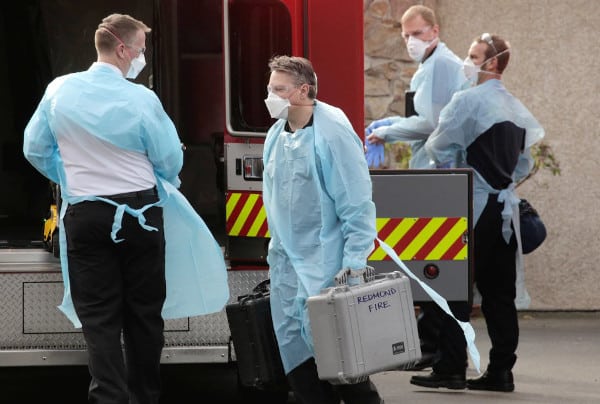
Supplies of masks and other protective equipment are dwindling worldwide—and risk running out as first responders continue to care for patients and require new sets. Some firefighting organizations are speculating that as much as 30% of the service community could be put out of commission by coronavirus—falling ill themselves or taking leave to care for sick loved ones. Volunteer fire departments are expected to suffer the most significant impact, as more people refuse to risk exposure to themselves and their families.
Guidance issued by the Department of Homeland Security’s Office of Health Affairs and the U.S. Fire Administration suggests that fire departments stop all non-emergency tasks as part of their pandemic response, including hydrant and code inspections.
Evacuated buildings provide an opportunity to perform ITM tasks required by fire codes without disrupting business
In the sample business preparedness guide offered in Annex C, NFPA 1600 emphasizes the need for emergency management programs to include fire prevention programs and working sprinkler systems:
Fire prevention program — Fire is the most common and significant threat to most businesses. Owner/operators can reduce the probability of fire by implementing fire safety programs, especially where flammable liquids or gasses are handled.
Automatic sprinklers — Locating a business or operation in buildings that are fully protected by automatic sprinklers significantly reduces an entity’s exposure to a catastrophic incident.
NFPA codes and standards and authorities having jurisdiction (AHJ) require regular inspection, testing, and maintenance (ITM) of fire protection systems to keep them in working order. Remember, sprinkler systems effectively control 96% of the fires that trigger them, saving lives and millions of dollars in property damage.
But scheduling ITM work, so it doesn’t disrupt business can be difficult, especially in 24/7 facilities, buildings with high levels of security, and even standard commercial properties. Property owners or facility managers must notify building occupants in advance of potentially disruptive work and schedule system shutdowns. Successful ITM often requires challenging coordination between contractors, facilities staff, administrative staff, and building occupants.
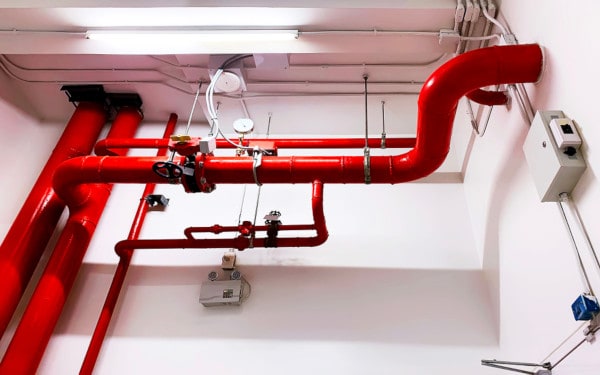
For instance, testing fire alarms can make it hard to focus on work. Flowing water from standpipes or fire pump tests might temporarily close areas where water is discharged. Activating smoke control systems can make doors difficult to operate, impact furniture or artwork, or draw in large quantities of outdoor air, impacting HVAC control.
Certain ITM activities temporarily impair fire protection systems, as well. When systems shut down for more than 10 hours in a 24-hour period, NFPA codes and AHJs force property owners to choose between building evacuations, fire watches, and other inconvenient and costly options to keep people safe.
Currently, however, many buildings are already evacuated as employees work from home during the pandemic. And that may give property owners an opportunity to perform required ITM activities without necessarily disrupting work or incurring the expense of implementing a fire watch. Completing all ITM requirements will ensure that a facility’s fire protection systems will act during an emergency—keeping fire damage from adding to the impact businesses may suffer from coronavirus.
Coronavirus plans should address employee behaviors that increase fire risks
Anxiety levels are soaring as coronavirus continues to spread, and many people worry that every throat tickle is the start of a potentially fatal disease. From grocery stores to healthcare facilities, organizations that must require employees to come to work are scrambling for preventative measures to keep everyone safe.
But unfortunately, that’s also leading to some behaviors that increase fire risks on a property.
Fire doors must remain operable during the coronavirus pandemic
Kristin Bigda, NFPA’s technical lead on building and life safety, recently responded to reports that some facilities are propping open fire doors to help people avoid touching potentially germ-infested handles.
“It is imperative that we not forfeit institutional elements of safety while working to address others,” Bigda urges in her post. “We need to balance the risk of the coronavirus against other real hazards that have the potential to harm multiple people in a very short window of time.”
Fire doors serve as a vital part of a building’s passive fire protection system. They’re specially constructed to slow or prevent the spread of fire and smoke between separate compartments in a structure, minimizing damage and helping people escape safely.
NFPA 1: Fire Code, NFPA 101: Life Safety Code, and NFPA 80: Standard for Fire Doors and Other Opening Protectives govern the installation, inspection, testing, and maintenance of fire doors. The documents require fire doors (as well as other opening protectives like shutters and windows) to always remain operable. Operability, Bigda explains, includes a fire door’s ability to open, close, and latch.
During regular operation, fire doors must either be kept closed and latched, or installed so they will automatically close and latch during a fire. Simply closing fire doors is not enough to prevent fires from spreading.
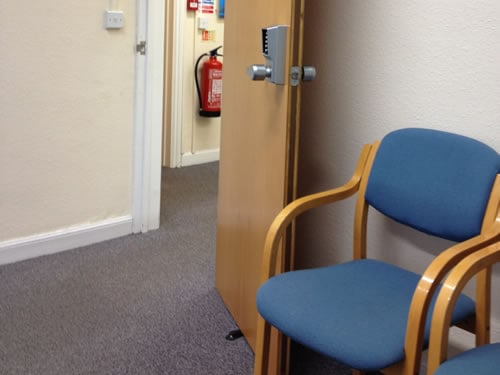
Building fires can generate pressures capable of forcing even the heaviest fires doors open if they are not held closed by latching force, rendering them incapable of stopping the spread. Anything that could prevent a fire door from closing and latching correctly during emergency conditions is a direct violation of fire codes. That includes propping the door open with objects, taping the latch, using wood wedges or kick-down door stops, or overriding the closing device.
Insurers may also refuse to pay claims if they discover that a fire door was wedged open.
Unfortunately, history is littered with examples of propped-open fire doors contributing to some of the deadliest fires in the U.S., such as the tragic Our Lady of the Angels school fire that killed 92 students and three adults. Letting unsafe practices slide also sets a bad precedent.
“While it may seem more ‘convenient’ or, in this case, a safer option from the perspective of spreading germs, interfering with fire door operation can have grave consequences during a fire,” NFPA states. “Allowing fire doors to be held open runs a risk of this becoming an accepted practice in the building for any number of situations. Building residents and staff should be taught code-compliant solutions and should not get into a habit of overriding fire safe practices.”
Failing to store stockpiled supplies safely can increase fire risks
Coronavirus panic-buying has spurred shortages of some essentials like toilet paper and prompted stockpiling excessive amounts in homes and workplaces. The toilet paper shortage has become such an issue that an Oregon police department actually posted a notice on Facebook asking people to stop calling 911 when they run out.
“It’s hard to believe that we even have to post this,” the Facebook post begins. “Do not call 9-1-1 just because you ran out of toilet paper. You will survive without our assistance.”
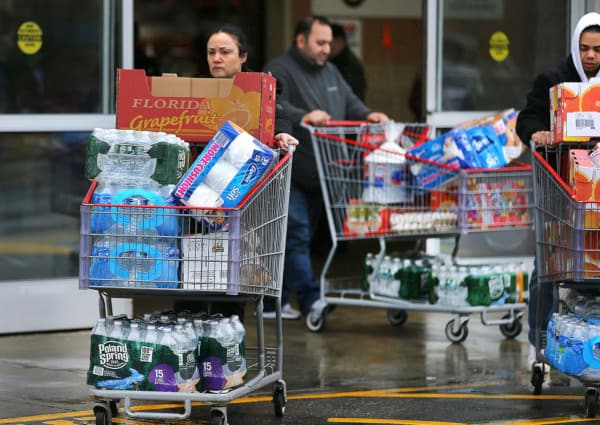
Unfortunately, responding to potential shortages by hoarding too many flammable supplies increases fire risks. In extreme cases, it could also lead to structural damage due to increased weight loading on floors.
Paper and other stockpiled supplies can ignite easily and burn rapidly. If a spark ignites where excessive amounts are improperly stored, flames can spread quickly—potentially overwhelming sprinkler systems not designed to accommodate such an abnormal amount of fuel. The National Institute of Health (NIH) asserts that fires that involve hoarding in homes or the workplace rank among the toughest for fire departments to fight.
Stockpiling some supplies may become necessary during a pandemic. But to avoid increased fire risks, consider these fire safety precautions:
- Avoid accumulating excessive amounts of unneeded combustible materials, such as cardboard boxes or paper products. Store combustible materials at least 3’ from heating appliances, electrical lights, and other heat sources. Properly dispose of items no longer in use to avoid stacking and accumulation on counters, tops of cabinets, floors, and desks.
- Avoid storing or using foam or plastic items (such as cups or utensils) close to heat sources. Not only can these materials quickly start a fire, but they burn rapidly and emit dense, toxic black smoke.
- At least 24 inches of ceiling clearance in non-sprinklered buildings is needed to allow manual hose streams to effectively reach the tops of burning piles and adjunct storage. At least 18 inches of clearance is needed in sprinklered areas to allow for the even distribution of water.
- Do not store combustible materials in corridors or egress paths that could jeopardize the safety of occupants leaving the building.
- Do not store items so that they obstruct access to portable fire extinguishers or other safety equipment. Fire extinguishers must remain clearly visible and easily accessible at all times.
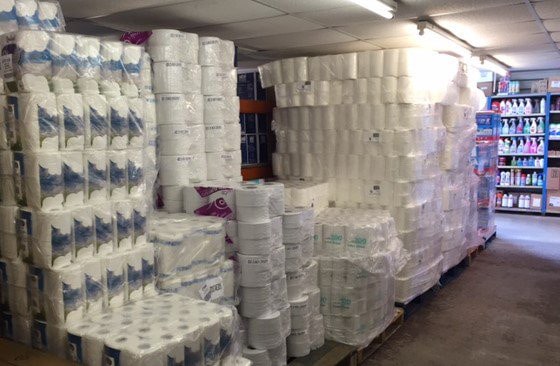
While we continue to hope for the best, coronavirus plans help businesses prepare for the worst
As the world grapples with the uncertainties that swirl around the unprecedented COVID-19 crisis, proper planning can help organizations take back control and reduce the impact on operations, employees, and customers. NFPA and OSHA offer a wealth of resources to help businesses prepare for changing patterns of commerce and potential disruptions to the workforce, supplies, or services.
And as organizations adjust to the new realities of the pandemic, maintaining the highest level of fire protection remains critical—preventing catastrophic fire losses from making an alarming situation even worse.
Quick Response Fire Supply (QRFS) remains fully operational and committed to helping your organization maintain the highest levels of fire safety. Call us at +1 (888) 361-6662 or email support@qrfs.com if you any questions or need help finding vital equipment.
QRFS hopes that all of our readers and customers stay safe and well. Please follow national and local government guidelines for social distancing and healthcare access—review the current Centers for Disease Control and Prevention (CDC) guidelines here—and continue to wash your hands regularly! We will get through this crisis!


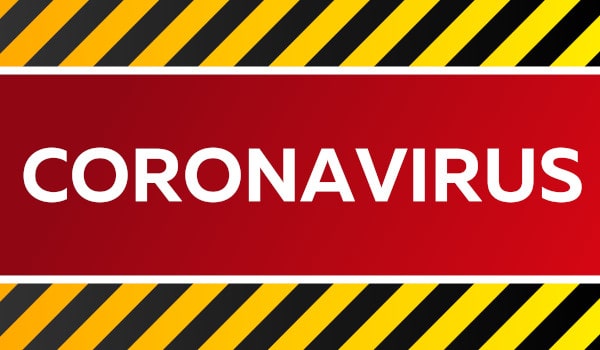
do we provide automatic fire sprinkler in operation theater of hospitals. what do codes recommend.
Also does code recommend drains for taking away water in case fire breaks out and fire sprinkler becomes operational.
NFPA 101 requires all buildings that are healthcare occupancies to have automatic sprinkler systems and coverage, though there are certain exceptions that are subject to approval to the local authority having jurisdiction (AHJ; often, your local fire marshal). Please consult with your AHJ and a fire sprinkler system professional to determine your building’s exact requirements. You can read more about this topic in our Hospital Fire Safety: NFPA Requirements for Protection and Compliance blog.
Thank you for this article! This is really very informative for us. I agree with you totally. It gives some true and insightful information on #334- corona virus emergency operatios plan: NFPA & OSHSA guidance. Great blog to share!!